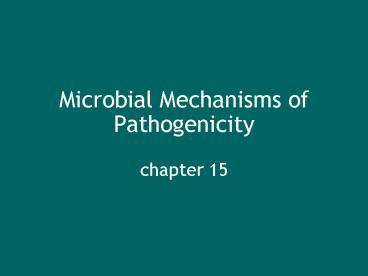Microbial Mechanisms of Pathogenicity - PowerPoint PPT Presentation
1 / 17
Title:
Microbial Mechanisms of Pathogenicity
Description:
direct damage in the immediate vicinity. grow & multiply ... scarlet fever/scarlatina. lysogenized bacteriophage codes for toxin. mechanisms of pathogenicity ... – PowerPoint PPT presentation
Number of Views:224
Avg rating:3.0/5.0
Title: Microbial Mechanisms of Pathogenicity
1
Microbial Mechanisms of Pathogenicity
- chapter 15
2
definitions
- pathogenicity
- the ability to cause disease
- virulence
- the extent of pathogenicity
- many properties are unclear or unknown
- disease requires
- entry portal of entry
- adherence capsules, ligands
- avoidance penetration enzyme production
- damage toxin production
3
portals of entry exit
exit
entry
4
preferred portal of entry
- entry DOES NOT EQUAL disease
- Streptococcus pneumoniae
- if inhaled can cause pneumonia
- if enters the G.I. tract, no disease
- Salmonella typhi
- if enters the G.I. tract can cause typhoid fever
- if on skin, no disease
5
pathogen damage to host
- direct damage in the immediate vicinity
- grow multiply
- far removed from site of invasion by toxins
- spread through blood and lymph
- by hypersensitivity
- hosts reaction may cause the damage
6
numbers of invading microbes
- ID50 infectious dose for 50 of test population
- ID50 for Vibrio cholerea 108 cells
- ID50 for inhalation anthrax - lt10,000 spores
- LD50 lethal toxin dose for 50 of test
population - LD50 botulinum toxin 0.03 ng/kg
- 1 mg of C. botulinum toxin can kill 106 guinea
pigs - LD50 E. coli shiga toxin 250 ng/kg
7
pathogenicity
8
toxins
- allow spread and cause damage to the host
- contributes to pathogenicity
- toxigenicity ability to produce a toxin
- toxemia toxin in blood
- toxoid immunization
- antitoxin Ab to toxin
9
bacterial toxins
10
exotoxins
- cytotoxins
- kill cells
- neurotoxins
- interfere with normal nerve impulses
- enterotoxins
- effect the G.I. tract lining
Figure 15.5
11
hemolysins
- ?-hemolytic streptococci
- hemolysins cause incomplete lysis
- ?-hemolytic streptococci
- hemolysins cause complete lysis
12
Clostridium exotoxins
- C. tetani
- spastic paralysis
- C. botulinum
- flaccid paralysis
13
Botox Therapeutics
14
V. cholerae enterotoxin
15
endotoxins fever
Figure 15.6
16
bacteriophage-induced pathogenicity
- S. pyogenes causes strepthroat
- scarlet fever/scarlatina
- lysogenized bacteriophage codes for toxin
17
mechanisms of pathogenicity
Figure 15.9































